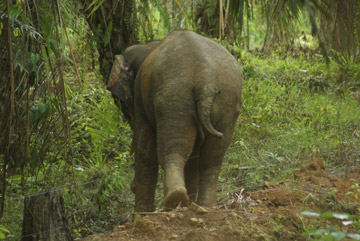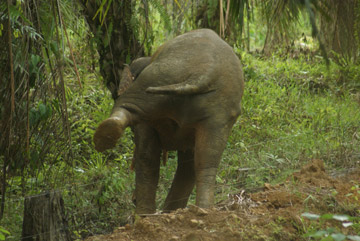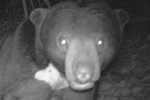An interview with Nurzahafarina Othman, a part of our on-going Interviews with Young Scientists series.

Bornean elephants tussling on the Kinabatangan River. Photo courtesy of: Nurzahafarina Othman.
In the Malaysian state of Sabah, where most conservation students are still foreigners—either European or American—Nurzahafarina Othman stands out: not only is she Malaysian, a Muslim, and a mother of a young daughter, but she’s rapidly becoming a top researcher and champion for the world’s smallest elephant: the Bornean elephant (Elephas maximus borneensis). Although sometimes described as a pygmy elephant, they still weigh 2,000 kilograms (4,400 pounds). The origin of these ‘tiny’ elephants in Malaysian Borneo have baffled scientists for decades.
“From the genetics data and historical records, we concluded that the Bornean elephant might be the survival of an extinct population from Java,” explains Othman. “So, these populations are unique.”
Although indomitable animals, the Bornean elephant is quickly vanishing: the subspecies is down to less than 2,000 animals, all of which are found in the Malaysian state of Sabah. Their forest habitat has been fractured by oil palm plantations, forcing elephants to maneuver through human-dominated landscapes. Exacerbating the situation, Bornean elephants are often considered pests in oil palm plantations as these pygmy giants can be quite destructive to the crop. The collision of palm oil plantations and Bornean elephant has lead to conflict: in 14 Bornean elephants were found dead, possibly due to poisoning from oil palm plantations.
 Nurzahafarina Othman taking down data. Photo courtesy of: Nurzahafarina Othman. |
In order to understand how the elephant navigate the increasingly fragmented landscapes, Othamn has conducted the first studies tracking individual elephants. Othman has found that while elephants generally stick to protected areas, they do enter the plantations, slipping over—and even under—electric fences and traversing trenches.
“We are not sure exactly why they use the oil palm plantations…But, personally, I think they are trying to establish new home range as the natural habitat available around Kinabatangan could not support the population anymore. Several bottlenecks around Sukau made situation worst as the elephants are pushed into limited spaces, and oil palm plantations could provide them with larger space to move to the next forest block,” Othman told mongabay.com.
According to Othman, the key to protecting the Bornean elephant in this new landscape is understanding their movements and then educating those who might come in contact with the elephants—such as oil palm workers.
“First of all, if we could understand the trends of elephant movement, we could predict the time when the elephants would occur in the plantations. Therefore, we could suggest to the oil palm companies to increase the man power to monitor their plantation,” Othman says. “Secondly, we should also train the plantation’s workers about the behaviour of elephants. To understand certain signals that might show if the elephant are really upset and ready to charge or just being curious with people presence.”
However, if the Bornean elephant is going to recover, changes in the landscape will be required.
“Ideally, more space to move and corridors to connect all the isolated population,” Othman says. “This will ensure they genetic diversity to increase again.”
Nurzhafarina Othman’s work is supported in part by: the Houston Zoo, Elephant Family, U.S. Fish & Wildlife Service, Colombus Zoo and the Mohamed bin Zayed Species Conservation Fund.
INTERVIEW WITH NURZHAFARINA OTHMAN

Elephants can be quite destructive in oil palm plantations, sometimes leading to conflict between workers and pachyderms. Photo courtesy of: Nurzahafarina Othman.
Mongabay: What’s your background?
Nurzhafarina Othman: I am originally from Kedah, a state at the northern part of Peninsular Malaysia. I came to Sabah in 2003 where I did my first degree at Universiti Malaysia Sabah and since I work with the Bornean elephant, I made up my mind to live there as long as I can. I am married and have a daughter who is three now. I did my Master’s degree as well in the same university and am currently doing my PhD at Cardiff University, UK.
Mongabay: How did you get started with Bornean elephants?
Nurzhafarina Othman: Ten years ago, the idea of wildlife conservation was new to Malaysian. During my final year project, I was just trying to be different from my course mates. I approached Dr. Sen Nathan who was at that time the director of Lok Kawi Wildlife Park. He suggested that I looked at the morphological difference of island and mainland elephants. So, I went to different zoos in Peninsular Malaysia collecting morphological measurement and I got A for my project due to my hard work, not because of the result 😉 At this time, my current supervisor Dr. Benoit Goossens came to Sabah with a Darwin Initiative Grant to do a project on the conservation genetics of Bornean elephant and he took me as his Master student. Since then, I always try to find ways to keep working with this species. When Benoit offered me to continue my PhD on the social behavior of elephant, I took the challenge and this is the best opportunity to learn, get to know and be close with the elephants!
Mongabay: What makes Bornean elephants different from their Asian counterparts?
Nurzhafarina Othman: Nurzhafarina Othman: From the genetics data and historical records, we concluded that the Bornean elephant might be the survival of an extinct population from Java. So, these populations are unique and there are only 2,000 left in the wild and can only be found in Sabah, although a few wander into Kalimantan from time to time. In term of behavior, elephants along the Lower Kinabatangan River, where I study them, are very mild and so far there are no death cases recorded there during human-elephant conflicts unlike in India, Sri Lanka and Indonesia.
However, a tourist was recently killed in Tabin Wildlife Reserve by a bull elephant. From our experience, the elephants in other populations act differently depending on the environment. Particularly translocated elephant tends to alter their behavior in new environment where they tend to become more aggressive and nervous, though we’re not sure if the bull elephant in question was translocated.
BORNEAN ELEPHANTS IN PLANTATIONS
Mongabay: The Bornean elephants you are a studying live in an area of large-scale oil palm development. How does this disrupt their social relationships and movement?
   Bornean elephant stepping over electric fence into an oil palm plantation. Photos courtesy of: Nurzahafarina Othman. |
Nurzhafarina Othman: So far, from movement data from different individuals, we could see that the elephants mainly used protected forest. However, there are a few instances where they ventured into the oil palm plantation and stayed there for quite some time. When they are in the plantation, when we simply plotted their speeds, it looks like these elephants are constantly moving in the plantation. In term of behavior, they became very silent. We are not sure if this is a problem to the elephants, but in term of their biology and physiology, this situation is not right. We are still analyzing the movement data to better understand their movement pattern.
Mongabay: Why are the elephants using palm oil plantations?
Nurzhafarina Othman: We are not sure exactly why they use the oil palm plantations. Some postulated because the elephant needs higher ground during raining season. Some believed, because the oil palm trees are easy and available for feeding. Some also think, that the oil palm plantations were the traditional route. But, personally, I think they are trying to establish new home range as the natural habitat available around Kinabatangan could not support the population anymore. Several bottlenecks around Sukau made situation worst as the elephants are pushed into limited spaces, and oil palm plantation could provide them with larger space to move to the next forest block.
Mongabay: Why does this pose dangers to them?
Nurzhafarina Othman: Human elephant conflicts will increase, both human and elephants lives are threatened because of this.

Collaring to track a Bornean elephant. Photo courtesy of: Nurzahafarina Othman.
Mongabay: Will you tell us how these elephants are getting in and out of palm oil plantations?
Nurzhafarina Othman: Usually the only protection of oil palm plantations at the boundary of natural forests are either electric fences or trenches. However, if these facilities are not well maintain or monitored, for example, their batteries are dead, they don’t switch on the electric fence or the electric fence are broken and damage, the elephants could always break in. The way the electric fence is erected without good planning as well is one of the possibility. At the same time, elephants are really good at adapting to their environment. At one point, I saw a sub adult male crossed over the electric fence without any problem.
Mongabay: How can plantations in the area become elephant-friendly?
Nurzhafarina Othman: First of all, if we could understand the trends of elephant movement, we could predict the time when the elephants would occur in the plantations. Therefore, we could suggest to the oil palm companies to increase the man power to monitor their plantation. Secondly, we should also train the plantation’s workers about the behaviour of elephants. To understand certain signals that might show if the elephant are really upset and ready to charge or just being curious with people presence. Most of the time, elephants are being misinterpreted of being nasty and [this has] resulted in wrong action towards them.
Mongabay: What do Bornean elephants need to thrive?
Nurzhafarina Othman: Ideally, more space to move and corridors to connect all the isolated population. This will ensure they genetic diversity to increase again. They also need people’s tolerance and understanding of their biology and physiology. Future development should take in account the well-being of wildlife before they cause harm to people and wrong action will be taken against these animals.
BORNEAN ELEPHANT DANGERS
Mongabay: Recently 14 elephants were found killed by an unidentified toxin. What’s the latest on this investigation?

Bornean elephants feeding in an oil palm plantation. Photo courtesy of: Nurzahafarina Othman.
Nurzhafarina Othman: It seems that the government has put a “full stop” to this investigation. Nothing much could be done because nobody come forward to help the investigation even though a huge sum of money are being offered to people who help to catch the culprit.
Mongabay: Do you have any hope that the people who killed them will be found?
Nurzhafarina Othman: Yes, obviously.
Mongabay: A tourist was recently killed by a male Bornean elephant in Tabin Wildlife Reserve. What should tourists and guides know about elephants to make sure this doesn’t happen again?
Nurzhafarina Othman: In this case, they should not have gone out of the trail. The idea of watching wildlife, is to observe how they live freely and normally in their natural habitat. Again, the same thing should be taught to tour guides, the behaviour of elephants. And they have to learn to respect the privacy of these animals.
Mongabay: Does Sabah need some improved guidelines for tourism in elephant areas?
Nurzhafarina Othman: Yes, indeed and [this is] very crucial as ecotourism is among the main economic resources to Sabah.
ELEPHANTS IN GENERAL
Mongabay: Why should Malaysians care about elephants?

Bornean elephants playing alongside the river. Photo courtesy of: Nurzahafarina Othman.
Nurzhafarina Othman: Only Malaysian have two different subspecies of Asian elephants. While it may not be useful for certain people, but the local and isolated people of Sukau, for example, hugely depend on these wildlife and nature as their source of income through home stay programs. As a Muslim, I believe we are carrying the duty as God caliph to look after and being fair to other [beings in] God’s creation. He will ask everyone of us how we treated the others. Elephants are special to Muslim and God even mentioned about elephant in the Quran in Sura Al-Fill means The Elephant.
Mongabay: What surprises people most about elephants?
Nurzhafarina Othman: They are very gentle and have their own personalities. They are good and fast learners and they can differentiate between who is the enemy and who is not. And they are good swimmers as well!
Mongabay: Will you tell us about your team on-the-ground?
Nurzhafarina Othman: My team are the best group of people, and I am so lucky to be able to work with them. They are very good with the elephants, and very good at maneuvering in the forest. They laugh and make jokes even though we are at the very final stage before fainted 😉 They are still young and have a lot of opportunity and brains to learn new stuffs. All of them are boys but they never treated me double with standard. They respect my decision and sometimes they advise me on things that I never learn at the university. They are working with HUTAN-KOCP and Danau Girang Field Centre and being local are a huge advantage for them as they can advise people in their own local language.
Mongabay: You’ve had a lot of success in your career so far. What advice would you give students—especially Malaysians—who are interested in becoming a wildlife biologist?
![]()
Tracking an elephant herd in an oil palm plantation. Photo courtesy of: Nurzahafarina Othman.
Nurzhafarina Othman: Never be afraid to get out from your comfort zones. Never be afraid to make mistakes and learn from it. Once you find people who believe in you, please think twice before you mess up. Living in this world is not all about money, but working with what you love and with people who loves you is more important. Doing research is about learning and there is no full stop to that. You will find new things and meet new people everyday. Our wildlife need us, our politician needs to listen from us. So, let’s take the challenge.
Mongabay: How can the general public aid Borneo’s elephants?
Nurzhafarina Othman:
1) Use palm oil in sustainable ways.
2) Talk about their plight though public media constantly, sign any petition that related to the conservation of this species and its habitat.
3) Learn about its behaviour in order to understand why they become aggressive.
4) Try to fund any research or conservation activities to help the conservation of wildlife and habitat protection.

Nurzhafarina Othman tracking Bornean elephants in the Kinabatangan. Photo courtesy of: Nurzahafarina Othman.

Panorama of elephants in the Kinabatangan landscape. Photo courtesy of: Nurzahafarina Othman.
Related articles
Unidentified toxin caused the deaths of Borneo elephants
(04/18/2013) After three months, officials still don’t know for certain what killed at least 14 Bornean elephants (Elephas maximus borneensis) in the Malaysian state of Sabah. However tests do indicate that the herd perished from a “caustic intoxicant,” possibly ingested accidentally or just as easily intentionally poisoned. A distinct subspecies, Bornean elephants are the world’s smallest with a population that has fallen to around 2,000 on the island.
New plantation concessions threaten Borneo pygmy elephants
(03/10/2013) Borneo pygmy elephants (Elephas maximus borneensis) are under threat in Indonesia’s new North Kalimantan province, where their habitat is set to be converted for rubber, jabon and sengon plantations. Experts worry that if the planned conversion goes ahead, the entire elephant population in Indonesian Borneo could be lost.
Malaysian NGOs boldly demand forest conservation action in Borneo

(02/28/2013) In an unusually bold statement catalyzed by the deaths of 14 rare elephants, six Malaysian NGOs today called on the Sabah state government to pursue ‘a more conservation focused agenda’ in managing the state’s forests. The demand comes shortly after the death of 14 endangered pygmy elephants — thought poisoned by an oil palm plantation developer — thrust Sabah’s environmental problems into the international spotlight.
80% of rainforests in Malaysian Borneo logged

(07/17/2013) 80 percent of the rainforests in Malaysian Borneo have been heavily impacted by logging, finds a comprehensive study that offers the first assessment of the spread of industrial logging and logging roads across areas that were considered some of Earth’s wildest lands less than 30 years ago. The research, conducted by a team of scientists from the University of Tasmania, University of Papua New Guinea, and the Carnegie Institution for Science, is based on analysis of satellite data using Carnegie Landsat Analysis System-lite (CLASlite), a freely available platform for measuring deforestation and forest degradation. It estimated the state of the region’s forests as of 2009.
63,700 ha of Borneo rainforest gains protection in Sabah
(06/22/2013) The Sabah Forestry Department has reclassified 63,700 hectares of rainforest zoned for logging as protected areas.
14 Bornean elephants found dead, likely poisoned

(01/31/2013) Wildlife officials in the Malaysian state of Sabah have found the bodies of 14 Bornean elephants in Gunung Rara Forest Reserve, and suspect that more may be found dead. While tests are pending, they believe the elephants were likely poisoned due to damage in the animals’ digestive tracts. Only around 2,000 Bornean elephants (Elephas maximus borneensis) are left on the island of Borneo with the vast bulk found in Sabah.
New palm oil concession imperils orangutan population in Borneo
(01/28/2013) Three conservation groups warn that a proposed palm oil plantation puts a significant Bornean orangutan (Pongo pygmaeus) population at risk in the Malaysian state of Sabah. The plantation, which would cover 400 hectares of private forest land, lies adjacent to Kulamba Wildlife Reserve, home to 480 orangutans.
Borneo may lose half its orangutans to deforestation, hunting, and plantations

(11/13/2012) Borneo will likely lose half of its orangutans if current deforestation and forest conversion trends continue, warns a comprehensive new assessment by an international team of researchers. The study, published in the journal PLoS ONE, overlays orangutan distribution with land use regulations in Malaysian and Indonesian Borneo. Borneo has suffered high rates of deforestation, logging, and forest conversion for industrial plantations in recent decades, endangering the world’s largest surviving populations of orangutans.
90 percent of oil palm plantations came at expense of forest in Kalimantan

(10/08/2012) From 1990 to 2010 almost all palm oil expansion in Kalimantan came at the expense of forest cover, according to the most detailed look yet at the oil palm industry in the Indonesian state, published in Nature: Climate Change. Palm oil plantations now cover 31,640 square kilometers of the state, having expanded nearly 300 percent since 2000. The forest loss led to the emission of 0.41 gigatons of carbon, more than Indonesia’s total industrial emissions produced in a year. Furthermore the scientists warn that if all current leases were converted by 2020, over a third of Kalimantan’s lowland forests outside of protected areas would become plantations and nearly quadruple emissions.
Photos: camera traps capture wildlife bonanza in Borneo forest corridor

(09/10/2012) Camera traps placed in a corridor connecting two forest fragments have revealed (in stunning visuals) the importance of such linkages for Borneo’s imperiled mammals and birds. Over 18 months, researchers with the Sabah Wildlife Department (SWD) and the Danau Girang Field Centre (DGFC) have photographed wildlife utilizing the corridor located in the Lower Kinabatangan Wildlife Sanctuary in Malaysian Borneo.
Sabah protects 700 sq mi of rainforest in Borneo
(08/30/2012) Sabah, a state in Malaysian Borneo, has reclassified 183,000 hectares (700 sq km) of forest zoned for logging concessions as protected areas.